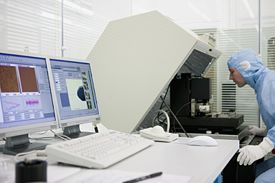Specific Process Knowledge/Characterization/AFM: Atomic Force Microscopy: Difference between revisions
| Line 5: | Line 5: | ||
The AFM: Nanoman is a product of Veeco Instruments. AFM stands for Atomic Force Microscope which is a scanning probe microscope where a sharp probe is scanned across a surface either in contact mode or tapping mode. The outcome is a topographic plot of the surface. It has a lateral solution of about 1 nm and a vertical resolution of less than 1 Å which makes it very suitable for topographic characterization in the nanometer regime. The limiting factor however is often the size of the probe in use. The tip radius of curvature (ROC) can be from 2 nm up to more than 20 nm depending on the chosen probe. The half cone angle of the tip can vary from less than 3<sup>o</sup> to over 25<sup>o</sup> giving problems resolving high aspect ratio structures. | The AFM: Nanoman is a product of Veeco Instruments. AFM stands for Atomic Force Microscope which is a scanning probe microscope where a sharp probe is scanned across a surface either in contact mode or tapping mode. The outcome is a topographic plot of the surface. It has a lateral solution of about 1 nm and a vertical resolution of less than 1 Å which makes it very suitable for topographic characterization in the nanometer regime. The limiting factor however is often the size of the probe in use. The tip radius of curvature (ROC) can be from 2 nm up to more than 20 nm depending on the chosen probe. The half cone angle of the tip can vary from less than 3<sup>o</sup> to over 25<sup>o</sup> giving problems resolving high aspect ratio structures. | ||
The main purposes are surface roughness measurements and step/structure high measurements in the nanometer and sub-micrometer regime. For larger structure see the topografic measurement page. | The main purposes are surface roughness measurements and step/structure high measurements in the nanometer and sub-micrometer regime. For larger structure see the [[Specific Process Knowledge/Characterization/Topographic measurement|topografic measurement]] page. | ||
To get some product information from the vendor take a look at Veeco's homepage [http://www.veeco.com/products/details.php?cat=1&sub=1&pid=178] | To get some product information from the vendor take a look at Veeco's homepage [http://www.veeco.com/products/details.php?cat=1&sub=1&pid=178] | ||
Revision as of 13:59, 8 January 2008
Nanoman

The AFM: Nanoman is a product of Veeco Instruments. AFM stands for Atomic Force Microscope which is a scanning probe microscope where a sharp probe is scanned across a surface either in contact mode or tapping mode. The outcome is a topographic plot of the surface. It has a lateral solution of about 1 nm and a vertical resolution of less than 1 Å which makes it very suitable for topographic characterization in the nanometer regime. The limiting factor however is often the size of the probe in use. The tip radius of curvature (ROC) can be from 2 nm up to more than 20 nm depending on the chosen probe. The half cone angle of the tip can vary from less than 3o to over 25o giving problems resolving high aspect ratio structures.
The main purposes are surface roughness measurements and step/structure high measurements in the nanometer and sub-micrometer regime. For larger structure see the topografic measurement page.
To get some product information from the vendor take a look at Veeco's homepage [1]
A rough overview of the performance of the AFM: Nanoman
| Purpose | Profiler for measuring micro structures. |
|
|---|---|---|
| Performance | Scan range xy |
Line scan x: 50 µm to 200 mm |
| . | Scan range z |
50 Å to 262 µm |
| . | Resolution xy |
down to 0.067 µm |
| . | Resolution z |
1Å, 10Å or 20Å |
| . | Max. scan depth as a function of trench width W |
1.2(W[µm]-5µm) |
| Hardware settings | Tip radius |
|
| Substrates | Substrate size |
|
| . | Substrate material allowed |
|
